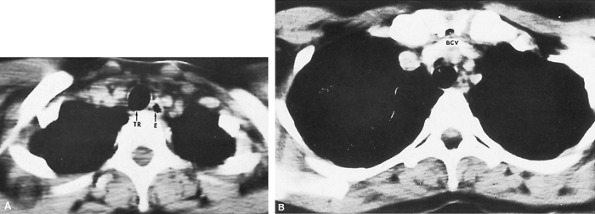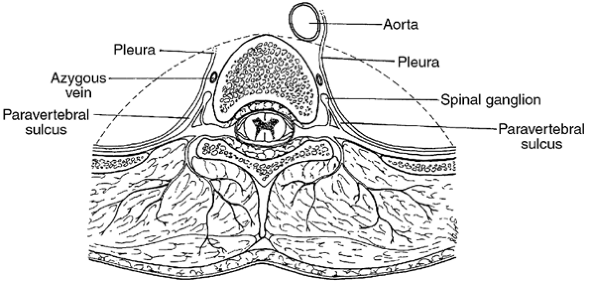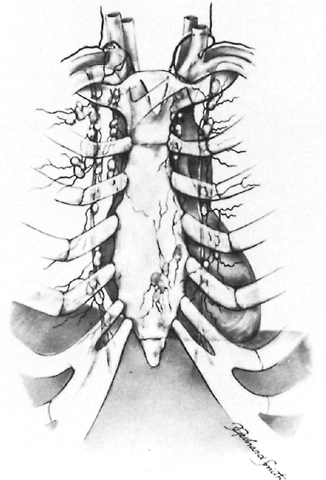131 - Transthoracic Resection of the Esophagus
Editors: Shields, Thomas W.; LoCicero, Joseph; Ponn, Ronald B.; Rusch, Valerie W.
Title: General Thoracic Surgery, 6th Edition
Copyright 2005 Lippincott Williams & Wilkins
> Table of Contents > Volume II > The Mediastinum > Section XXV - Anatomy > Chapter 154 - The Mediastinum, Its Compartments, and the Mediastinal Lymph Nodes
Chapter 154
The Mediastinum, Its Compartments, and the Mediastinal Lymph Nodes
Thomas W. Shields
The mediastinum is defined as the thoracic space that lies between the two pleural cavities. It extends from the thoracic inlet cephalad to the superior surface of the diaphragm caudad. It is bounded by the undersurface of the sternum ventrally and the anterior longitudinal spinal ligament dorsally. The paravertebral areas (the costovertebral sulci) situated bilaterally are not truly within the mediastinum, but lesions arising within these regions are classically defined in medical literature as mediastinal in origin.
SUBDIVISIONS OF THE MEDIASTINUM
Numerous radiographic and surgical subdivisions of the mediastinum have been used in the literature. The more commonly used anatomic subdivisions are the superior, anterior, middle, and posterior mediastinal areas. The boundaries and locations of these subdivisions are defined differently by the many authors who have written on the subject. As a consequence, confusion abounds in the radiologic, pediatric, and surgical literature about these divisions. The same organ or structure may be located in two or more regions as it passes from the thoracic inlet to the diaphragm. More important, these commonly used divisions place the trachea and the esophagus, both derived from the foregut, in different compartments, which I believe is inappropriate.
In 1972, I suggested that a simple anteroposterior division of the space be used (Fig. 154-1). This schema consists of an anterior compartment, a visceral compartment, and the paraventral sulci bilaterally. At the thoracic inlet, the visceral compartment occupies the entire space anterior to the vertebral column, and the two paravertebral sulci are posterior and lateral to the anterior surface of the spinal column. The anterior compartment (the prevascular space) is limited superiorly by the innominate vessels and does not communicate directly with the thoracic inlet (Figs. 154-2 and 154-3), although the space may be entered through the inlet by the appropriate surgical techniques (see Chapter 161). Each compartment extends inferiorly to the diaphragm and is limited laterally by the mediastinal surface of the respective parietal pleura. The anterior compartment is bounded anteriorly by the undersurface of the sternum inferior to the innominate vessels and posteriorly by an imaginary line formed by the anterior surfaces of the great vessels and pericardium. The visceral compartment (also referred to as the postvascular space, the middle mediastinum, or the central space) extends from the posterior surface of the superior portion of the sternum above the innominate vessels and the
P.2344
posterior limit of the anterior compartment below these vessels to the ventral surface of the vertebral column. Thus, as noted, the visceral compartment occupies the thoracic inlet. Often, it is convenient to divide the superior portion of the visceral compartment at or just below the thoracic inlet into pretracheal and retrotracheal areas. The paravertebral sulci (costovertebral regions) (Fig. 154-4), as noted, are not truly mediastinal in location but are potential spaces along each side of the vertebral column and adjacent proximal portions of the ribs.
 |
Fig. 154-1. Schematic illustration of the mediastinal subdivisions and the paravertebral sulcus, as seen from the left. Note that the anterior compartment does not extend to the thoracic inlet but is limited superiorly by the brachiocephalic (innominate) vessels. |
 |
Fig. 154-2. Schematic illustration of a transverse body section directly caudad to the thoracic inlet. Note that the pretracheal space of the visceral compartment extends to the sternum. The prevascular space (the anterior compartment) may be reached anteriorly but does not occupy any true space in the thoracic inlet. LCA, left carotid artery; SCA, subclavian artery. |
STRUCTURES IN THE ANTERIOR COMPARTMENT
The anterior compartment normally contains the thymus gland, internal mammary vessels, lymph nodes, connective tissue, and fat. Displaced parathyroid glands may be occasionally found in this compartment. Rarely, true ectopic thyroid tissue may be located in this compartment.
 |
Fig. 154-3. A. Computed tomographic (CT) image directly above the thoracic inlet. The trachea (TR) and esophagus (E) are easily identifiable. B. CT image at the sternoclavicular level. The left innominate vein (left brachiocephalic vein; BCV) courses anterior to the subclavian, carotid, and brachiocephalic arteries. These vascular structures limit the anterior mediastinal compartment from direct confluence with the more superior thoracic inlet. |
 |
Fig. 154-4. Schematic illustration of normal structures in the paravertebral sulcus, fourth thoracic level, as seen from above. |
STRUCTURES IN THE VISCERAL COMPARTMENT
The visceral compartment contains the pericardium, heart, and great vessels. The trachea, proximal portions of the right and left main-stem bronchi, and esophagus are the major visceral structures. Extensive lymphatic tissues, the vagus and phrenic nerves, the supraaortic and paraaortic bodies, multiple nerve plexuses and fibers, the thoracic duct, the proximal portion of the azygos venous system, connective tissue, and fat also are contained in this compartment.
P.2345
STRUCTURES IN THE PARAVERTEBRAL SULCI
The paravertebral sulci primarily contain the proximal portions of the intercostal arteries and veins, proximal portion of the anterior ramus, and the ramus communicans of the intercostal nerves, thoracic spinal ganglions, sympathetic trunk and its major branches, and connective and lymphatic tissues as well as the distal azygos vein.
MEDIASTINAL LYMPH NODES
The mediastinum is rich in lymphatics and lymph node aggregates that drain the various organs within the mediastinum, the structures in the neck, and portions of those just below the diaphragm and the adjacent thoracic parietes. These lymph nodes may be the site of localized inflammatory disease, primary lymphatic tumors, or metastatic disease from primary sites within the thorax, chest wall, breast, or more distant locations.
As with the mediastinal space, the major lymph node groups can be divided into three major anatomic divisions. These are found in the anterior compartment, visceral compartment, and paravertebral sulci bilaterally.
Anterior Compartment
Two groups of lymph node chains are in the anterior compartment: (a) the sternal (anterior parietal or internal mammary) group, and (b) the anterior mediastinal (prevascular) group (Fig. 154-5). The sternal group lies along the internal mammary arteries bilaterally; a few lymph nodes may be directly retrosternal. These anterior parietal nodes are more constant superiorly. These lymph nodes drain the upper anterior abdominal wall, anterior thoracic wall, anterior portion of the diaphragm, and medial portions of the breast, and they communicate with the anterior visceral group of nodes. The efferent drainage is to the cervical nodes and the respective lymphatic ducts bilaterally.
The prevascular group lies anterior and lateral to the thymus as well as just anterior to the great vessels. These lymph nodes are frequently referred to as the anterior mediastinal nodal group of the mediastinum. The prevascular lymph nodes drain the anterior portion of the pericardium, anterior part of the heart, thymus, thyroid, diaphragm, and anterior portion of the mediastinal pleura. Drainage from the lung also occurs into this group of nodes, primarily from the upper lobe of the left lung.
Visceral Compartment
The major lymph node groups in the visceral compartment are those associated with drainage from the lungs and esophagus. These are described in Chapters 6 and 124. However, a less conspicuous group, termed the parietal group, has been described. These parietal lymph nodes of the visceral mediastinal compartment are located around the pericardial attachment to the diaphragm, and they drain the adjacent diaphragm and portions of the liver. Anteriorly, their enlargement may be confused with the pleuropericardial fat pad. Castellino and Blank (1972) described the involvement of these lymph nodes by lymphoma. Lymph nodes are also present at the site of the junction of the phrenic nerve and the diaphragm bilaterally.
 |
Fig. 154-5. Anterior mediastinal lymph nodes, primarily those of the anterior parietal groups along the internal mammary vessels and beneath the sternum, schematically illustrated. From Fraser RG, Pare JAP: Diagnosis of Diseases of the Chest. 2nd Ed. Vol. 1. Philadelphia: WB Saunders, 1978. With permission. |
Paravertebral Sulci
According to Fraser and associates (1988), two groups of nodes belonging to both the parietal and visceral chains lie in the posterior mediastinal compartment (the paravertebral sulci). One is the posterior visceral group (described previously) and is better termed the posterior (paraesophageal) nodes of the visceral compartment. This
P.2346
group of nodes is not located in the paravertebral sulci. The second and only truly paravertebral group is the intercostal (posterior parietal) group, which lies laterally in the intercostal spaces and medially in the paravertebral areas adjacent to the heads of the ribs (Fig. 154-6). These nodes drain the intercostal spaces, parietal pleura, and vertebral column. They may be involved in inflammatory disease processes, such as tuberculosis of the spine, or occasionally may be the site of a primary lymphoma in the chest.
 |
Fig. 154-6. Paravertebral sulci lymph nodes. The intercostal (posterior parietal) group lies laterally, in the intercostal spaces, and medially, in the paravertebral area adjacent to the heads of the ribs. The visceral (posterior mediastinal nodes) group is situated along the lower esophagus and descending aorta and is properly included in the node groups of the visceral compartment. From Fraser RG, Pare JAP: Diagnosis of Diseases of the Chest. 2nd Ed. Vol. 1. Philadelphia: WB Saunders, 1978. With permission. |
REFERENCES
Castellino RA, Blank N: Adenopathy of the cardiophrenic angle (diaphragmatic) lymph nodes. AJR Am J Roentgenol 114:509, 1972.
Fraser RG, Pare JAP: Diagnosis of Diseases of the Chest. 2nd Ed. Vol. 1. Philadelphia: WB Saunders, 1978.
Fraser RG, et al: Diagnosis of Diseases of the Chest. 3rd Ed. Vol. 1. Philadelphia: WB Saunders, 1988, p. 129.
Shields TW: Primary tumors and cysts of the mediastinum. In Shields TW (ed): General Thoracic Surgery. 1st Ed. Philadelphia: Lea & Febiger, 1972, p. 908.
EAN: 2147483647
Pages: 203
- Linking the IT Balanced Scorecard to the Business Objectives at a Major Canadian Financial Group
- Measuring and Managing E-Business Initiatives Through the Balanced Scorecard
- Governing Information Technology Through COBIT
- The Evolution of IT Governance at NB Power
- Governance Structures for IT in the Health Care Industry